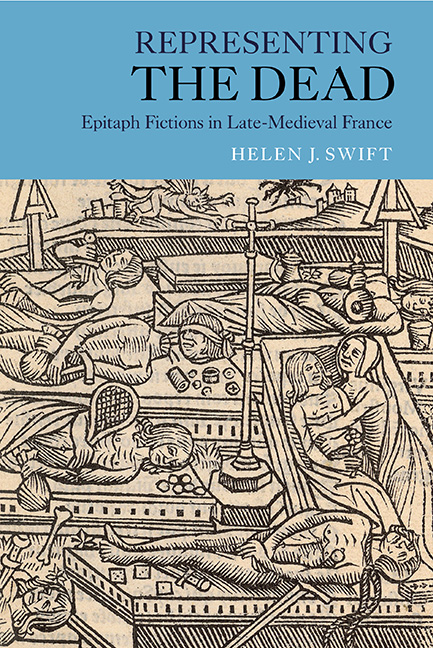Book contents
- Frontmatter
- Dedication
- Contents
- List of Illustrations
- Acknowledgements
- Note on Quotations
- List of Abbreviations
- Chronology of Epitaph Fictions
- Introduction: Representing the Dead
- 1 Framing Identity: ‘je suis’ and ‘cy gist’
- 2 Identity and/as Echo: the ‘Belle Dame’ querelle and Le Jardin de plaisance
- 3 Dying to be told: storytelling and exemplarity ‘selon le stile Jehan Bocace’
- 4 Placing the Dead: Cemeteries, Hospitals and Temples
- Afterword: Illustrating the dead
- Coda: Re-Member Me
- Appendix: Early Editions of the Jardin de plaisance et fleur de rethorique
- Bibliography
- Index
- Already Published
- Frontmatter
- Dedication
- Contents
- List of Illustrations
- Acknowledgements
- Note on Quotations
- List of Abbreviations
- Chronology of Epitaph Fictions
- Introduction: Representing the Dead
- 1 Framing Identity: ‘je suis’ and ‘cy gist’
- 2 Identity and/as Echo: the ‘Belle Dame’ querelle and Le Jardin de plaisance
- 3 Dying to be told: storytelling and exemplarity ‘selon le stile Jehan Bocace’
- 4 Placing the Dead: Cemeteries, Hospitals and Temples
- Afterword: Illustrating the dead
- Coda: Re-Member Me
- Appendix: Early Editions of the Jardin de plaisance et fleur de rethorique
- Bibliography
- Index
- Already Published
Summary
Epitaph fictions are concerned with identity as process rather than product: with ‘je suis’ and ‘cy gist’ as questions to be posed rather than simple affirmations; with the composition of an identity that arises out of a highly charged moment of decomposition; with competing or collaborating narrative agencies and with the possibilities enabled by imaginative fiction to explore the plurality of posthumous identity, the didactic stature and the ontological status of the dead; and with the complexity of placing the dead in an allegorical architectural structure and the uses to which this framework can be put to dramatise death as a transition into a new mode and phase of being. These late-medieval writers see the dead as opportunities not simply to commemorate a person but also to interrogate how identity is constructed, challenged, dismantled and revised, and to probe the very nature, processes and agencies of literary representation. In a broader perspective, this supports a view of medieval selfhood as self-fashioning, with death as an acme point of view for exposing and exploiting ‘the fashioning of human identity as a manipulable, artful process’. But the posthumous story of a self is not unproblematically constitutive of that self; it displays the fissures and contradictions in competing narratives of an individual's identity, and the tensions between different agencies performing that composition, exposing the inherent slipperiness of the idea of selfhood.
A dead self is at once the purest and the messiest form of representation: it is necessarily a fiction (‘comme si’ [as if]), as being dead can only ever be imagined, never experienced, and by dint of that unknowability it gives rise to complexity in its articulation. The syntagm ‘I am’, enunciated posthumously, is, as we have seen, no straightforward transparent utterance; its deixis is puzzling or pluralised, its being riddling and uncertain. The dead have no fixed abode, not even – or perhaps especially – in the text that records their demise. The fictional frameworks in which they are represented celebrate their fictionality as they animate the inanimate, performing the impossible, holding in precarious coherence a physically dismembered body so as to highlight the very action of re-membering that pieces together its selfhood. They act not to restore lost wholeness so much as to disclose the fundamental fracture in identity itself, which is always already dead, belatedly catching up with, and catching up in its construction, the individual whom it records.
- Type
- Chapter
- Information
- Representing the DeadEpitaph Fictions in Late-Medieval France, pp. 305 - 306Publisher: Boydell & BrewerPrint publication year: 2016

